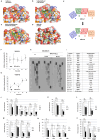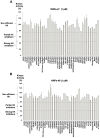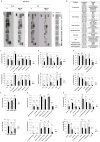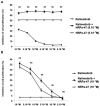Neuropilin Antagonists (NRPas) Block the Phosphorylation of the Cancer Therapeutic Key Factor p38α Kinase Triggering Cell Death
- PMID: 40286084
- PMCID: PMC11990468
- DOI: 10.3390/molecules30071494
Neuropilin Antagonists (NRPas) Block the Phosphorylation of the Cancer Therapeutic Key Factor p38α Kinase Triggering Cell Death
Abstract
Neuropilin-1 is henceforth a relevant target in cancer treatment; however, its way of action remains partly elusive, and the development of small inhibitory molecules is therefore required for its study. Here, we report that two small-sized neuropilin antagonists (NRPa-47 and NRPa-48), VEGF-A165/NRP-1 binding inhibitors, are able to decrease VEGF-Rs phosphorylation and to modulate their downstream cascades in the triple-negative breast cancer cell line (MDA-MB-231). Nevertheless, NRPas exert a divergent pathway regulation of MAPK phosphorylation, such as JNK-1/-2/-3, ERK-1/-2, and p38β/γ/δ-kinases, as well as their respective downstream targets. However, NRPa-47 and NRPa-48 apply a common down-regulation of the p38α-kinase phosphorylation and their downstream targets, emphasising its central regulating role. More importantly, none of the 40 selected kinases, including SAPK2a/p38α, are affected in vitro by NRPas, strengthening their specificity. Taken together, NRPas induced cell death by the down-modulation of pro-apoptotic and anti-apoptotic proteins, cell death receptors and adaptors, heat shock proteins (HSP-27/-60/-70), cell cycle proteins (p21, p27, phospho-RAD17), and transcription factors (p53, HIF-1α). In conclusion, we showed for the first time how NRPas may alter tumour cell signalling and contribute to the down-modulation of the cancer therapeutic key factor p38α-kinase phosphorylation. Thus, the efficient association of NRPas and p38α-kinase inhibitor strengthened this hypothesis.
Keywords: VEGF; breast cancer; neuropilin antagonists; neuropilin-1; p38α kinase.
Conflict of interest statement
Authors Nicolas Lopez and Yves Lepelletier were employed by the company W-MedPhys. All the authors have read the manuscript, concur with its content, and state that its content has not been submitted elsewhere. The authors declare no competing financial interests and no conflict of interest.
Figures








Similar articles
-
NRPa-308, a new neuropilin-1 antagonist, exerts in vitro anti-angiogenic and anti-proliferative effects and in vivo anti-cancer effects in a mouse xenograft model.Cancer Lett. 2018 Feb 1;414:88-98. doi: 10.1016/j.canlet.2017.10.039. Epub 2017 Oct 28. Cancer Lett. 2018. PMID: 29111348
-
Oestrogen prevents cardiomyocyte apoptosis by suppressing p38α-mediated activation of p53 and by down-regulating p53 inhibition on p38β.Cardiovasc Res. 2011 Jan 1;89(1):119-28. doi: 10.1093/cvr/cvq265. Epub 2010 Aug 19. Cardiovasc Res. 2011. PMID: 20724307 Free PMC article.
-
p38α MAPK-mediated induction and interaction of FOXO3a and p53 contribute to the inhibited-growth and induced-apoptosis of human lung adenocarcinoma cells by berberine.J Exp Clin Cancer Res. 2014 Apr 26;33(1):36. doi: 10.1186/1756-9966-33-36. J Exp Clin Cancer Res. 2014. PMID: 24766860 Free PMC article.
-
p38α MAPK pathway: a key factor in colorectal cancer therapy and chemoresistance.World J Gastroenterol. 2014 Aug 7;20(29):9744-58. doi: 10.3748/wjg.v20.i29.9744. World J Gastroenterol. 2014. PMID: 25110412 Free PMC article. Review.
-
The p38alpha mitogen-activated protein kinase as a central nervous system drug discovery target.BMC Neurosci. 2008 Dec 3;9 Suppl 2(Suppl 2):S12. doi: 10.1186/1471-2202-9-S2-S12. BMC Neurosci. 2008. PMID: 19090985 Free PMC article. Review.
References
MeSH terms
Substances
LinkOut - more resources
Full Text Sources
Research Materials
Miscellaneous

